
Short but intense are perhaps the best two adjectives to describe the winter in the Northern Alps, home to the largest area of lift served skiing in Europe. The start of the season promised much with the first snows in Tignes above 2000 meters falling on the 27th of August. Summer snow is not that unusual but on the 17th of October there was more serious snow fall right down to 1200 meters with some 30 cm at 2000 meters that enabled some ski tourers to take advantage of the conditions to get in an early summit, skis on from the car.
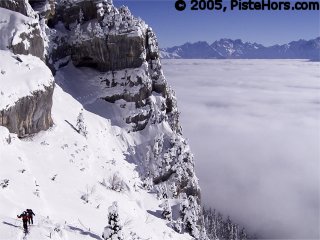
Ski Mountaineering at 1500 meters in January
Talk was of a long, bumper ski season much like 2003-2004 when it snowed at the end of October and with continual top ups through to mid-May many backcountry skiers saw close to 9 months of action. Unfortunately it was not to be. The October snows melted as quickly as they had arrived and skiers had to wait until the 28th of December for the first real snow in mid-mountain areas in the Northern Alps.
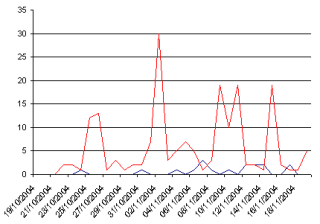
Ski Outings Autumn 2004/2005 compared
The generally poor early conditions are illustrated by the graph. This compares the number of outings made by ski tourers in October/November 2004 (blue) compared to the same period in 2003 (red) as recorded by the website CamptoCamp. Chamonet’s webcam recorded the scene, parched brown slopes as far as the glaciers.

Mont Blanc in late November (source:chamonet.com)
The picture in the Central Pyrénées, rising star of French skiing over the last few years, was much better. So much so that some stations were caught napping in mid-November by bumper falls. The micro-station of the Monts d’Olmes had scheduled its annual safety check for the end of November even though snow was abundant from the middle part of the month. Ax-les-Thermes, les Angles, Formiguères and Pas de la Casa in Andorra were able to take advantage of the early snow and open in November.
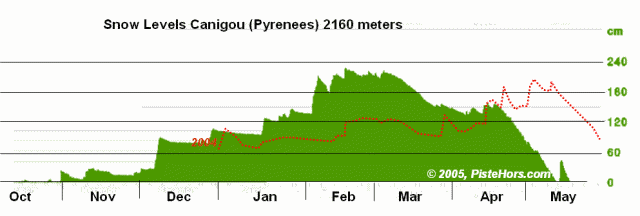
Canigou in the Western Pyrénées
Following the end of December snowfall a long blocking anti-cyclone brought almost spring snow conditions to the Northern Alps then from mid-January to mid-March there were fantastic conditions, at least below 2000 meters altitude. If the weather stations at La Gua, situated at 1600 meters in the Vercors massif is compared with that in the Ecrins, some 60km to the west but at almost twice the altitude then, after a late start the Vercors passed the Ecrins snow depth in mid-January, a lead it kept right through to the end of the season. It was not just lack of snow but strong northerly winds that blew with each snow episode at altitude, stripping summits and ridgelines bare. Météo France stated that snow levels above 2000 meters were at a 30 year low for the Savoie. Crevasses on glaciers were poorly bridged and some off-piste skiers and boarders found out to their cost exactly what this meant.
This picture is almost a mirror image of last season, where conditions were better at altitude and in the Southern Alps. The pre-Alps of the Vercors and Chartreuse all recorded snow depths around 3 meters and the situation in the Aravis, Bauges and Belledonne was also above average.
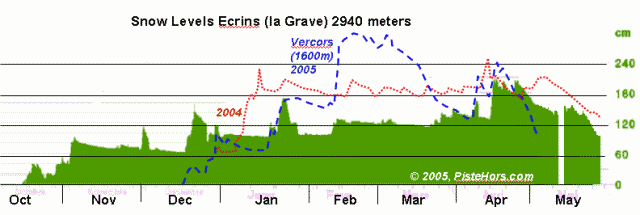
Snow Levels in the Ecrins / Vercors Compared
With the exception of the Devoluy massif which benefited from some of the superb conditions experienced in the Vercors and the border areas with the Isère and Savoie the Southern Alps had an awful season. The first real snow only came in early April. This enabled the micro-resort of Mont Serein, high on the slopes of Mont Ventoux to open for the weekend of the 17th of April and boast 80cm of snow on its runs, something not seen during the rest of the season. Other ski resorts were insulated to some extent by a massive investment in snow canons over the past three years but backcountry enthusiasts either had to travel north or practice other sports such as mountain biking. Pity poor Pra-Loup who shut down in mid-March during the Easter Holidays with just a few strips of muddy snow to ski on. Even snow canons could not save them as an extremely dry winter meant their reservoir for snow making was empty. Perhaps a warning for resorts further north who believe these heavy weapons are a suitable response to the weather gods.
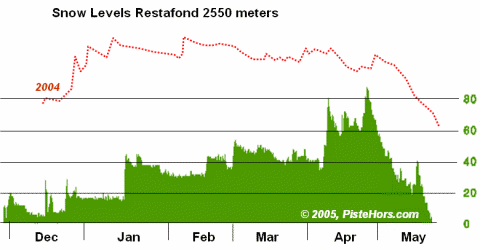
Col de Restafond in the Southern Alps
February and early March brought intense cold over most of France including the Alps, Corsica, Massif Central and Pyrénées. A mass of cold air from Northern Europe was driven southwards by North-East winds. Even the lemon crop in the Mediterranean was frozen on the branch and 10cm of snow fell on the Promenade des Anglais in Nice. The autoroute between Nice and Italy was paralyzed for 24 hours. Unfortunately little of this snow made it inland to the Maritime Alps. 30 year temperature records were broken, not for the last time during this winter. The village of Saugues in the Haute-Loire situated at 960 meters altitude recorded a temperature of -29.5°C on the 1st of March. A record for electricity consumption was passed: 86.024 Mega Watts. In Corsica, which has suffered a dry autumn, hydro electricity plants ran dry and power cuts were made. The French Electricity company flew in emergency generators from as far afield as Canada and Scotland.
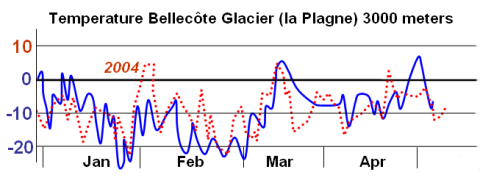
Temperatures on the Bellecôte
Overall temperatures in southern half of France were between -1 and -3C below average for the first 3 months of the year. At the same time precipitation was 50% of average in the Southern Alps. If the temperatures on the weather station on the Bellecôte near the ski resort of la Plagne in the Savoie are compared we see that February and early March were colder but the end of the season was slightly warmer. The traditional rule of not putting away winter woolies before the “Ice Saints” on the 10-12th of May still seems to hold true.
The cold weather had an economic cost. Roads in the Massif Central were blocked for much of the February and early March and even the Le Mont Dore train link had trouble getting through with over a meter of snow on the tracks some mornings. The Savoie highways department reported that they had used as much road salt by the middle of February as during the whole of 2004. In mid-February three hundred British package tourists had to spend and uncomfortable 24 hours in their coaches when they got stuck on the way to Andorra. It wasn’t even great news for the Pyrénées ski resorts. While some of the lower resorts were having the best conditions and visitor numbers for years Puyvalador suffered a power cut that stopped the lifts, it took hard pressed engineers two days to restore current and Artouste went bankrupt before the start of the season. With the avalanche risk at maximum (5 out of 5) roads were closed, fuel-oil ran short and tourists, especially lucrative Spanish clients, were unable to reach resorts.

Snow levels at the Bellecôte Glacier
In the Northern Alps everyone was looking forward to a bonanza of ski touring once spring came. On the 1st of March temperatures were -13C in the Isère, a couple of weeks later they were closer to 23C. With winds blowing from the south to south-west, Spring had indeed sprung. Even at 3000 meters on the summit of the Bellecôte close to la Plagne a meter of snow melted in a fortnight. Lower down little was skiable below 1500 meters even on Northern slopes. Couloirs were out of condition having been ravaged by avalanches. With poor snow above 2000 meters, glaciers routes out of condition and the excellent snow lower down rapidly melting skiers felt like they were being caught in a vice.
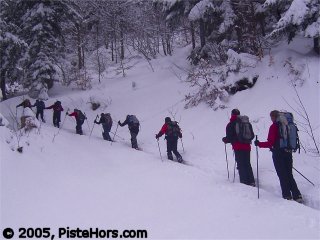
Chartreuse Mountains, April 10th
Just as ski mountaineers were talking about “end of the season” the weather took another turn. Over the weekend of the 9th April around 80cm snow fell, again largely on the pre-Alps but even the high mountains of the Savoie and Ecrins saw a few centimeters. Ski tourers were out in force that weekend in the Chartreuse and Vercors. For many an unexpected end of season bonanza even if there had been a similar episode over the 8th of May the year before. The end of the month saw further snowfall but with warm temperatures, the end of the month saw the zero isotherm around 4000 meters with temperatures of 20C recorded at 1000 meters. The Pyrenees and Vercors were able to survive with their good stocks of winter snow but ski touring was effectively over in many mid-mountain areas. The first week of May experienced temperatures 3 to 5 C above the long term average in the Northern Alps and Pyrénées. May Day was the hottest for 60 years in the Savoie, another record broken with temperatures more typical of mid-June. Even backcountry travelers heading out at 5am found the snow to be rotten with a thin freeze/thaw crust above 2500 meters.
Summary
So another excellent year for the Pyrénées for both ski and snowboard tourers and the ski resorts. It seems like investments in modern lifts and snowmaking are paying off. The situation in the Massif-Central was one of lack of snow in the south but a good, if variable season in the north. Corsica also had a good year, with snow down to the coast in February. The mid-mountain areas of the Northern Alps had a superb season, once it got started although the end was somewhat disappointing. The high Savoie resorts of Tignes, Val d’Isère and Val Thorens saw around half their annual snowfall totals above 2000 meters. With many resorts expanding and increasingly relying on snow making, les Arcs has plans to cover 40% of its ski area with canons, one hydrology expert we spoke to predicted that water conflicts between ski resorts and local communities were going to be increasingly common in the next decade. Vaulnaveys-le-Haut a small community in the Isère is concerned about plans by Chamrousse to divert the flow of the Vernon to its snow canon reservoir. This stream also feeds the drinking water of Vaulnaveys. The Southern Alps are in an even worse state with farmers wondering how they will make it through the summer and the French Electricity Company worried about production from its reservoirs in the area.
This has once again made climate change a hot topic. Was 2005 one of the real winters that Jacques Villecrose had forseen for the early part of the 21st century in his 1998 paper on climate change and skiing? Last year was one of the 8th warmest years on record but the Col du Porte recorded one of its best years for snow cover for 40 years. 2005 should continue that trend. So it seems that despite, or maybe because of, warmer temperatures we are entering a period of better but somewhat more volatile snow cover after the drought years of the mid-90s.
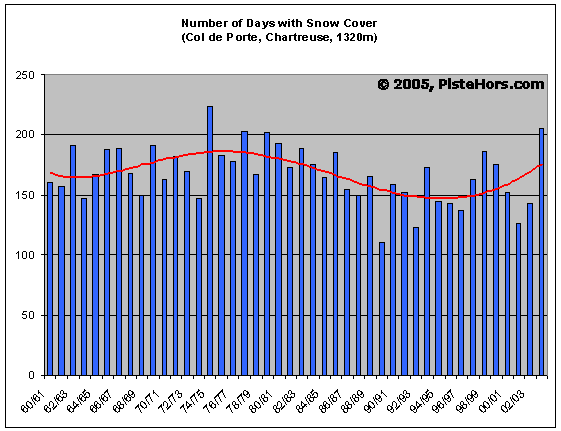
Days with snow cover at the Col de Porte.
The weather observatory at the Mont Aigoual to the south of Cérvennes mountains has accurate snowfall records stretching back over a century. It is the last remaining manned station in the French mountains. The Aigoual Massif is the first mountain obstacle for the warm, damp winds coming up from the Mediterranean. The high altitude makes it into a powerful rain (and snow) making machine. Its 1567 meter summit is one of the wettest places in France.
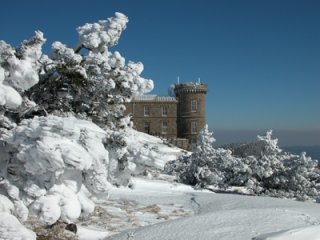
Mont Aigoual Weather Observatory
It sees huge variations in climate with over a 50C temperature span from the coldest days in winter to the warmest days of summer. The winter of 1995-1996 was the snowiest since records began in 1894, with a total of 10.39 meters of fresh snow. The trends seem similar to the Col de Porte with an increase in snowfall coinciding with the boom construction years in the French ski industry and, despite 95-96, a drought in the late 80s and 90s. Once again we appear to be entering a period with more snowfall at least during the main winter months. One thing is sure, climate change is the norm rather than the exception.
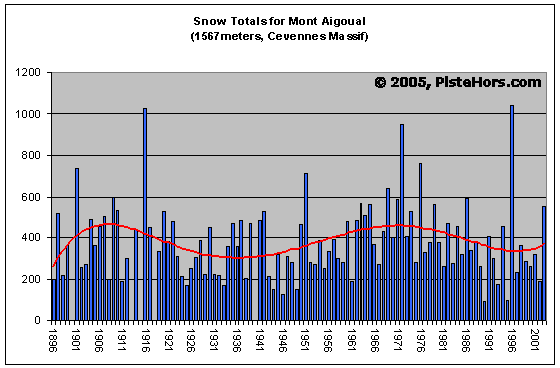
100 Year Snow Totals at Mont Aigoual
References:
Automatic Weather Stations of Météo France
Volopress Rubrique: Neige
Skitour.fr
Skipass.com
NOAA
Infoclimat
Aigoual Weather Observatory
Climate Change Hits Alps Hardest